1995 CHEVROLET TAHOE brakes
[x] Cancel search: brakesPage 88 of 486
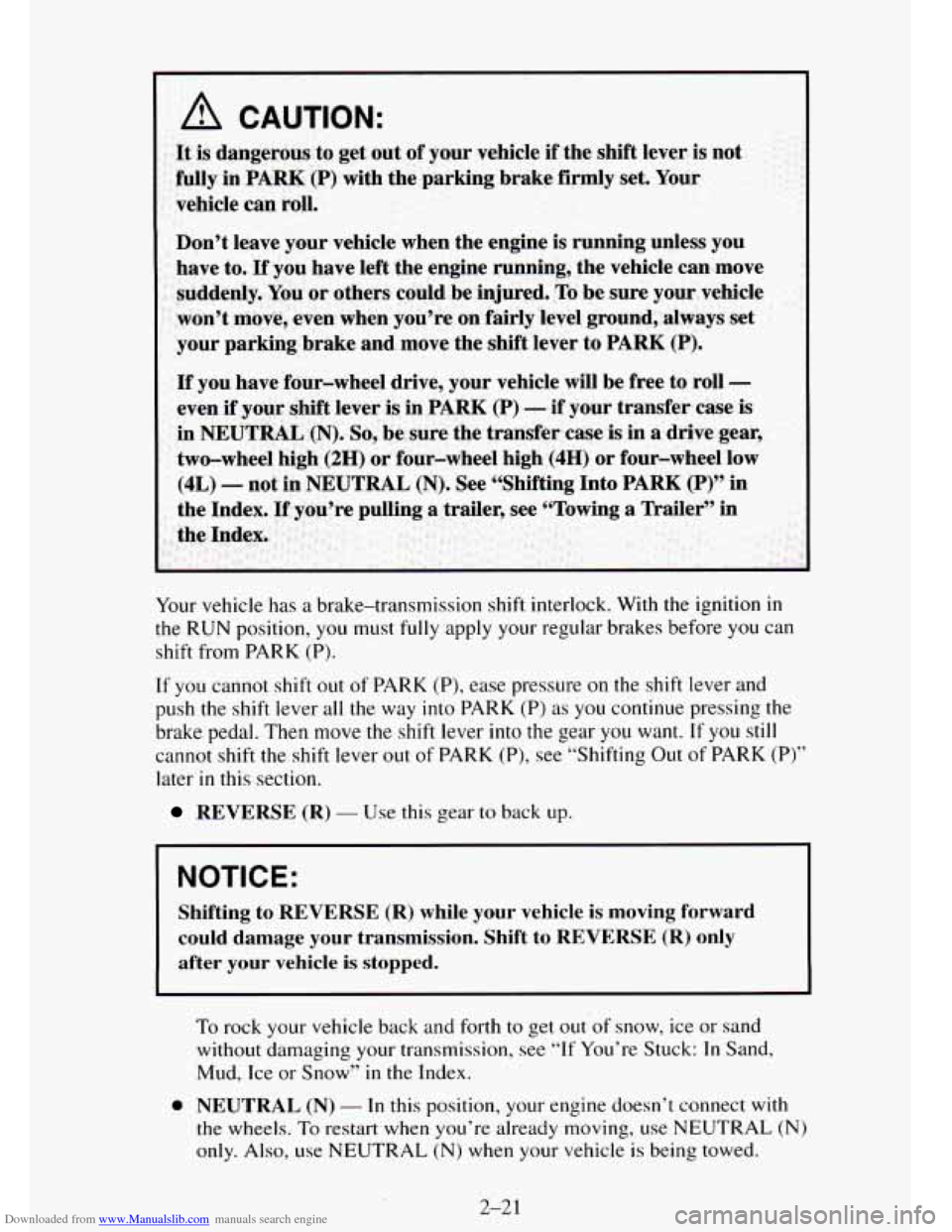
Downloaded from www.Manualslib.com manuals search engine Your vehicle has a brake-transmission shift interlock. With the ignition in
the RUN position, you must fully apply your regular brakes before you can
shift from PARK (P).
If you cannot shift out
of PARK (P), ease pressure on the shift lever and
push the shift lever
all the way into PARK (P) as you continue pressing the
brake pedal. Then move the shift lever
into the gear you want. If you still
cannot shift the shift lever out of PARK (P), see “Shifting Out of PARK (P)”
later in this section.
REVERSE (R) - Use this gear to back up.
NOTICE:
Shifting to REVERSE (R) while your vehicle is moving forward \
could damage your transmission. Shift to REVERSE (R) only
after your vehicle
is stopped.
To rock your vehicle back and forth to get out’of snow, ice or sand
without damaging your transmission, see “If You’re Stuck: In Sand,
Mud, Ice or Snow” in the Index.
0 NEUTRAL (N) - In this position, your engine doesn’t connect with
the wheels. To restart when you’re already moving, use NEUTRAL
(N)
only. Also, use NEUTRAL (N) when your vehicle is being towed.
2-21
Page 89 of 486
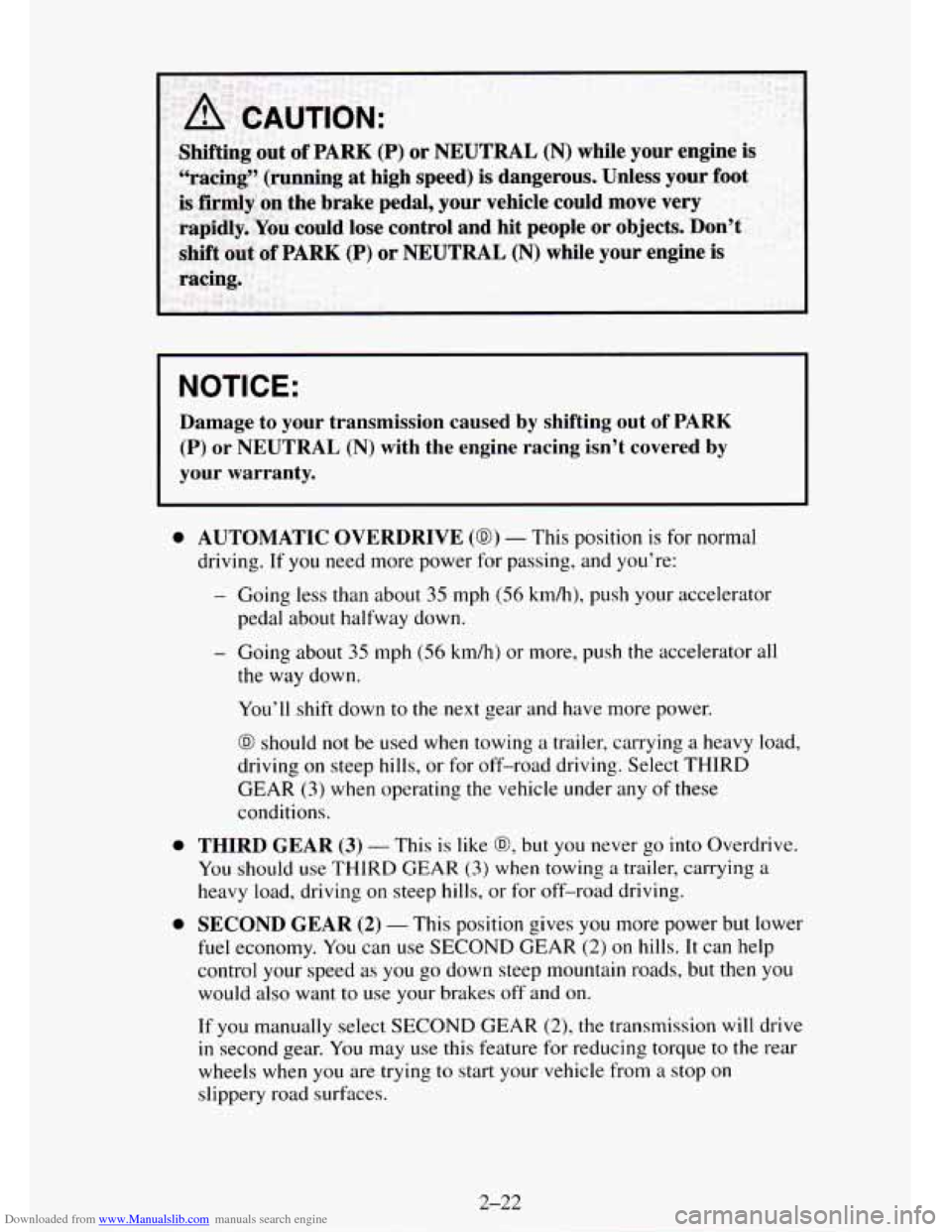
Downloaded from www.Manualslib.com manuals search engine NOTICE:
Damage to your transmission caused by shifting out of PARK
(P) or NEUTRAL (N) with the engine racing isn’t covered by
your warranty.
0 AUTOMATIC OVERDRIVE (@) - This position is for normal
driving. If you need more power for passing, and you’re:
- Going less than about 35 mph (56 km/h), push your accelerator
pedal about halfway down.
- Going about 35 mph (56 km/h) or more, push the accelerator all
the way down.
You’ll shift down
to the next gear and have more power.
@ should not be used when towing a trailer, carrying a heavy load,
driving on steep hills, or for off-road driving. Select THIRD
GEAR
(3) when operating the vehicle under any of these
conditions.
0 THIRD GEAR (3) - This is like @, but you never go into Overdrive.
You should use THIRD GEAR (3) when towing a trailer, carrying a
heavy load, driving on steep hills, or for off-road driving.
0 SECOND GEAR (2) - This position gives you more power but lower
fuel economy. You can use SECOND GEAR (2) on hills. It can help
control your speed
as you go down steep mountain roads, but then you
would also want to use your brakes off and on.
If you manually select
SECOND GEAR (2), the transmission will drive
in second gear. You may use this feature for reducing torque to the rear
wheels when
you are trying to start your vehicle from a stop on
slippery road surfaces.
2-22
Page 90 of 486
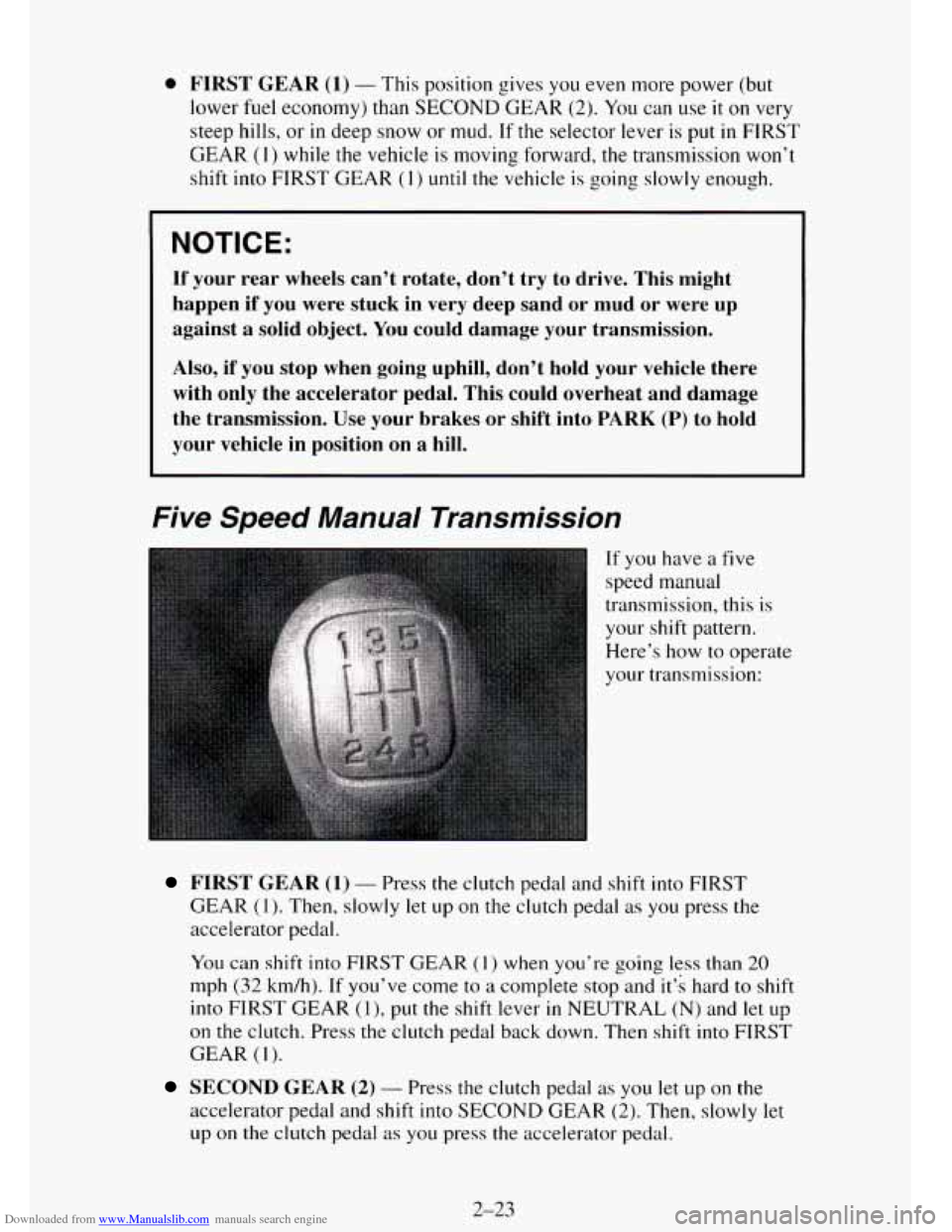
Downloaded from www.Manualslib.com manuals search engine 0 FIRST GEAR (1) - This position gives you even more power (but
lower fuel economy) than SECOND GEAR (2).
You can use it on very
steep hills, or
in deep snow or mud. If the selector lever is put in FIRST
GEAR
(1 j while the vehicle is moving forward, the transmission won’t
shift
into FIRST GEAR (1) until the vehicle is going slowly enough.
NOTICE:
If your rear wheels can’t rotate, don’t try to drive. This might
happen if you were stuck in very deep sand or mud
or were up
against a solid object. You could damage your transmission.
Also, if you stop when going uphill, don’t hold your vehicle there
with only the accelerator pedal. This could overheat and damage\
the transmission. Use your brakes or shift into
PARK (P) to hold
your vehicle in position on a hill.
Five Speed Manual Transmission
If you have a five
speed manual
transmission, this is
your shift pattern.
Here’s how to operate
your transmission:
FIRST GEAR (1) - Press the clutch pedal and shift into FIRST
GEAR (1). Then, slowly let up on the clutch pedal as you press the
accelerator pedal.
You can shift into FIRST GEAR (1) when you’re going less than 20
mph (32 km/h). If you’ve come to a complete stop and it’% hard to shift
into FIRST GEAR (I), put the shift lever in NEUTRAL (Nj and let up
on the clutch. Press the clutch pedal back down. Then shift into FIRST
GEAR
(1).
SECOND GEAR (2) - Press the clutch pedal as you let up on the
accelerator pedal and shift into SECOND GEAR (2). Then, slowly let
up on the clutch pedal as you press the accelerator pedal.
2-23
. -.
Page 93 of 486

Downloaded from www.Manualslib.com manuals search engine Parking Brake
To set the parking brake:
Hold the regular brake
pedal down with your
right foot. Push down
the parking brake
pedal with your left
foot.
If the ignition is on, the brake system warning light will come on.
To release the parking brake:
Hold the regular brake
pedal down. Pull the
lever, located just
above the parking
brake pedal, marked
BRAKE RELEASE,
to release the parking
brake.
If the ignition is on when the parking brake is released, the brake system
warning light will
go off.
I NOTICE:
Driving with the parking brake on can cause your rear brakes to
overheat. You may have to replace them, and you could also
damage other parts
of your vehicle.
If you are towing a trailer and are parking on any hill: See “Towing a
Trailer” in the Index. That section shows what to do first to keep the trailer
from moving.
2-26
I I
Page 95 of 486
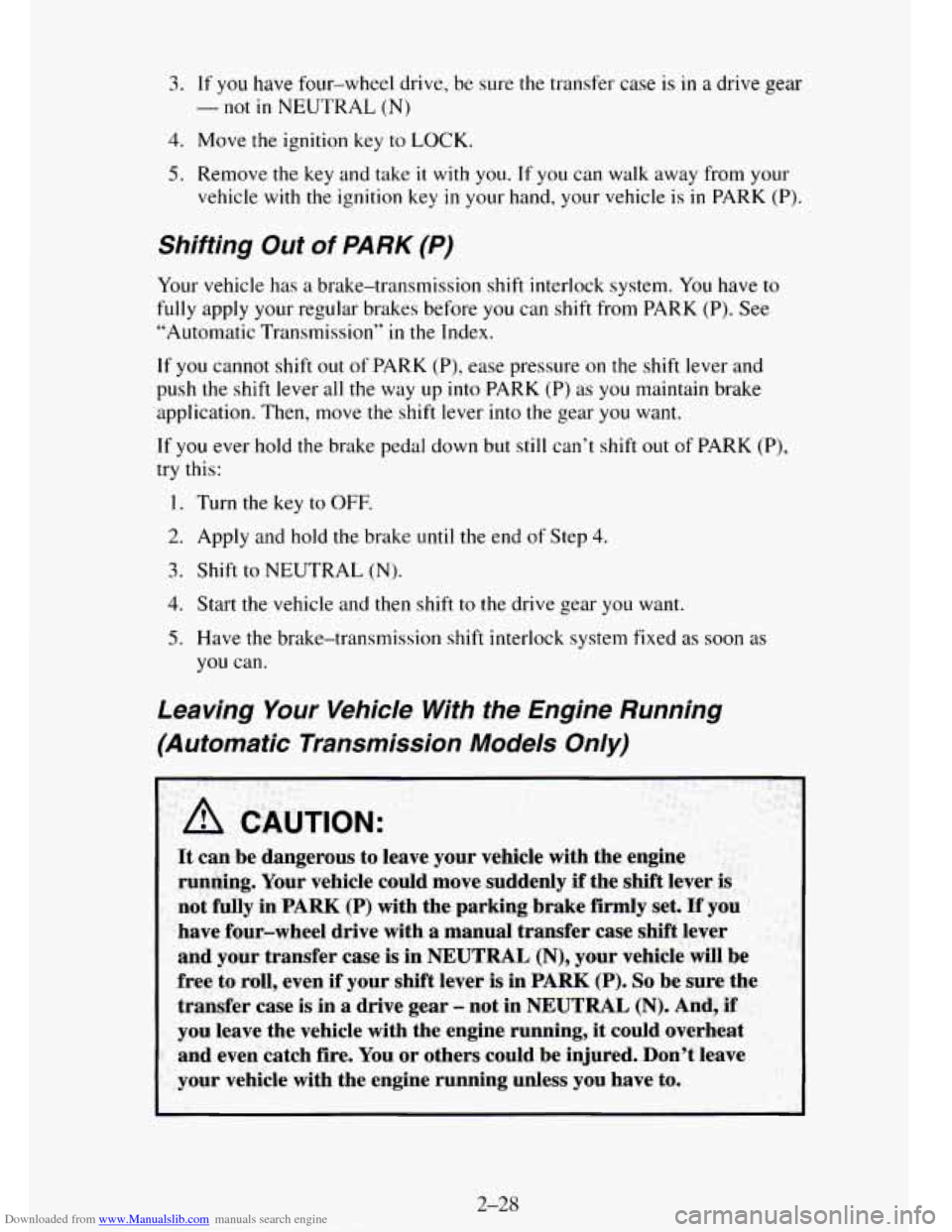
Downloaded from www.Manualslib.com manuals search engine 3. If you have four-wheel drive, be sure the transfer case is in a drive gear
4. Move the ignition key to LOCK.
-not in NEUTRAL (N)
5. Remove the key and take it with you. If you can walk away from your
vehicle with the ignition key
in your hand, your vehicle is in PARK (P).
Shifting Out of PARK (P)
Your vehicle has a brake-transmission shift interlock system. You have to
fully apply your regular brakes before you can shift from PARK (P). See
“Automatic Transmission”
in the Index.
If
you cannot shift out of PARK (P), ease pressure on the shift lever and
push the shift lever all the way up into PARK
(P) as you maintain brake
application. Then, move the shift lever into the gear you want.
If
you ever hold the brake pedal down but still can’t shift out of PARK (P),
try this:
1. Turn the key to OFF.
2. Apply and hold the brake until the end of Step 4.
3. Shift to NEUTRAL (N).
4. Start the vehicle and then shift to the drive gear you want.
5. Have the brake-transmission shift interlock system fixed as soon as
you can.
Leaving Your Vehicle With the Engine Running
(Automatic Transmission
Models Only)
It can be dangerous to leave your vehicle with the engine
running. Your vehicle could move suddenly if the shift lever
is
not fully in PARK (P) with the parking brake firmly set. If you
have four-wheel drive with
a manual transfer case shift lever
and your transfer case
is in NEUTRAL (N), your vehicle will be
free to roll, even if your shift lever
is in PARK (P). So be sure the
transfer case is in
a drive gear - not in NEUTRAL (N). And, if
you leave the vehicle with the engine running, it could overheat
and even catch
fire. You or others could be injured. Don’t leave
your vehicle with the engine running unless you have to.
2-28
Page 111 of 486

Downloaded from www.Manualslib.com manuals search engine When you apply your brakes, the Cruise Control shuts off.
A CAUTION:
Cruise control can be dangerous where you can’t drive safely
at a steady speed. So, don’t use your cruise control on winding
roads or in heavy traffic.
Cruise control can be dangerous on slippery roads. On such
roads, fast changes in tire traction can cause needless wheel
spinning, and you could lose control. Don’t use cruise control
on slippery roads.
To Set Cruise Control
I Move the Cruise
Control switch
to
ON.
If you leave your cruise control switch on when you’re not using
cruise, you might hit
a button and go into cruise when you don’t
want to. You could be startled and even lose control. Keep the
cruise control switch
OFF until you want to use it.
Get up to the speed you want.
Push in the set button at the end of the lever and release it.
Take your foot off the accelerator pedal.
2-44
Page 139 of 486
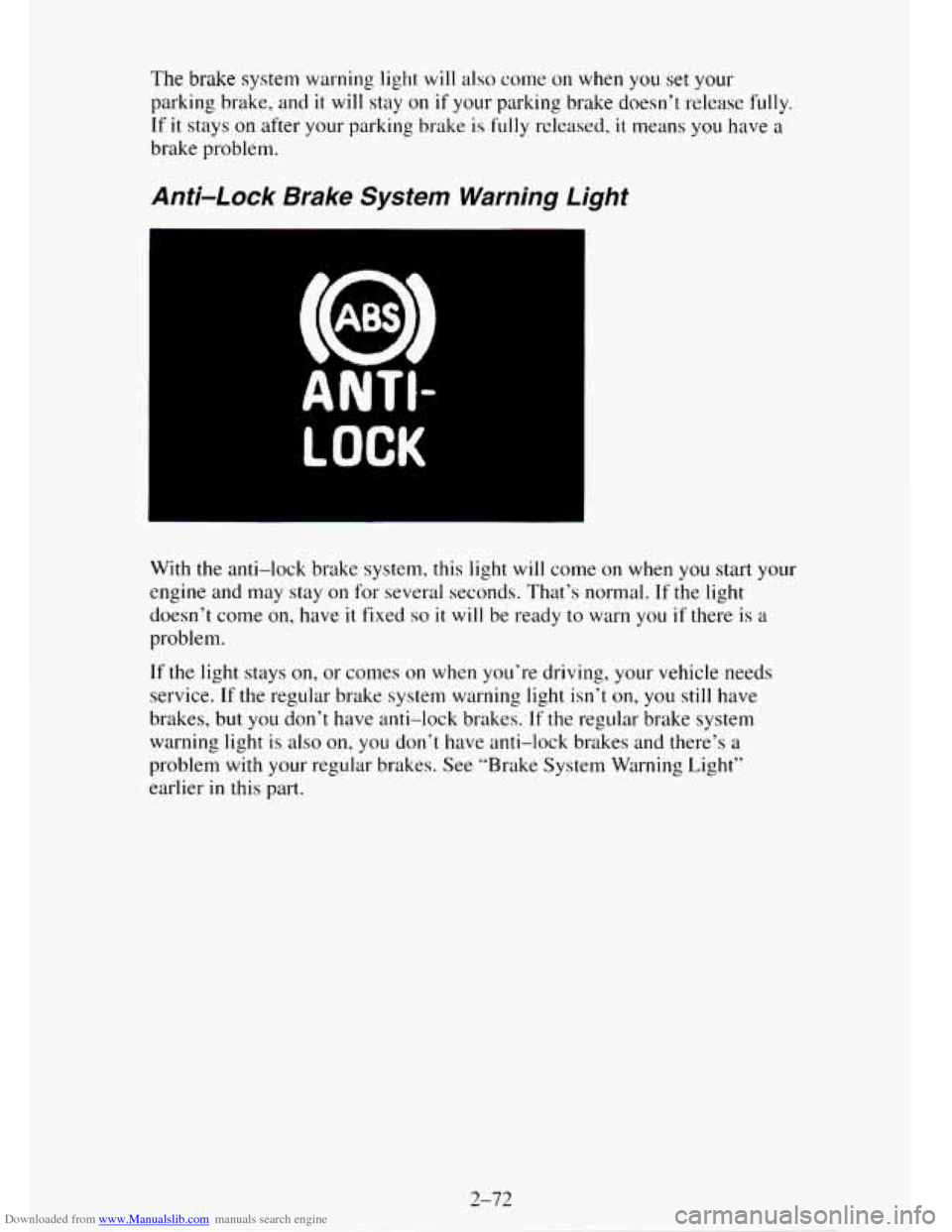
Downloaded from www.Manualslib.com manuals search engine The brake system warning light will also come on when you set your
parking brake, and it will stay on if your parking brake doesn’t release fully.
If it stays on after your parking brake is fully released, it means you have a
brake problem.
Anti4 ock Brake System Warning Light
ANTI-
LOCK
With the anti-lock brake system, this light will come on when you start your
engine and may stay on for several seconds. That’s normal.
If the light
doesn’t come on, have
it fixed so it will be ready to warn you if there is a
problem.
If the light stays on, or comes on when you’re driving, your vehicle needs
service.
If the regular brake system warning light isn’t on, you still have
brakes, but
you don’t have anti-lock brakes. If the regular brake system
warning light
is also on, you don’t have anti-lock brakes and there’s a
problem with your regular brakes. See “Brake System Warning Light”
earlier
in this part.
2-72
.~
Page 187 of 486
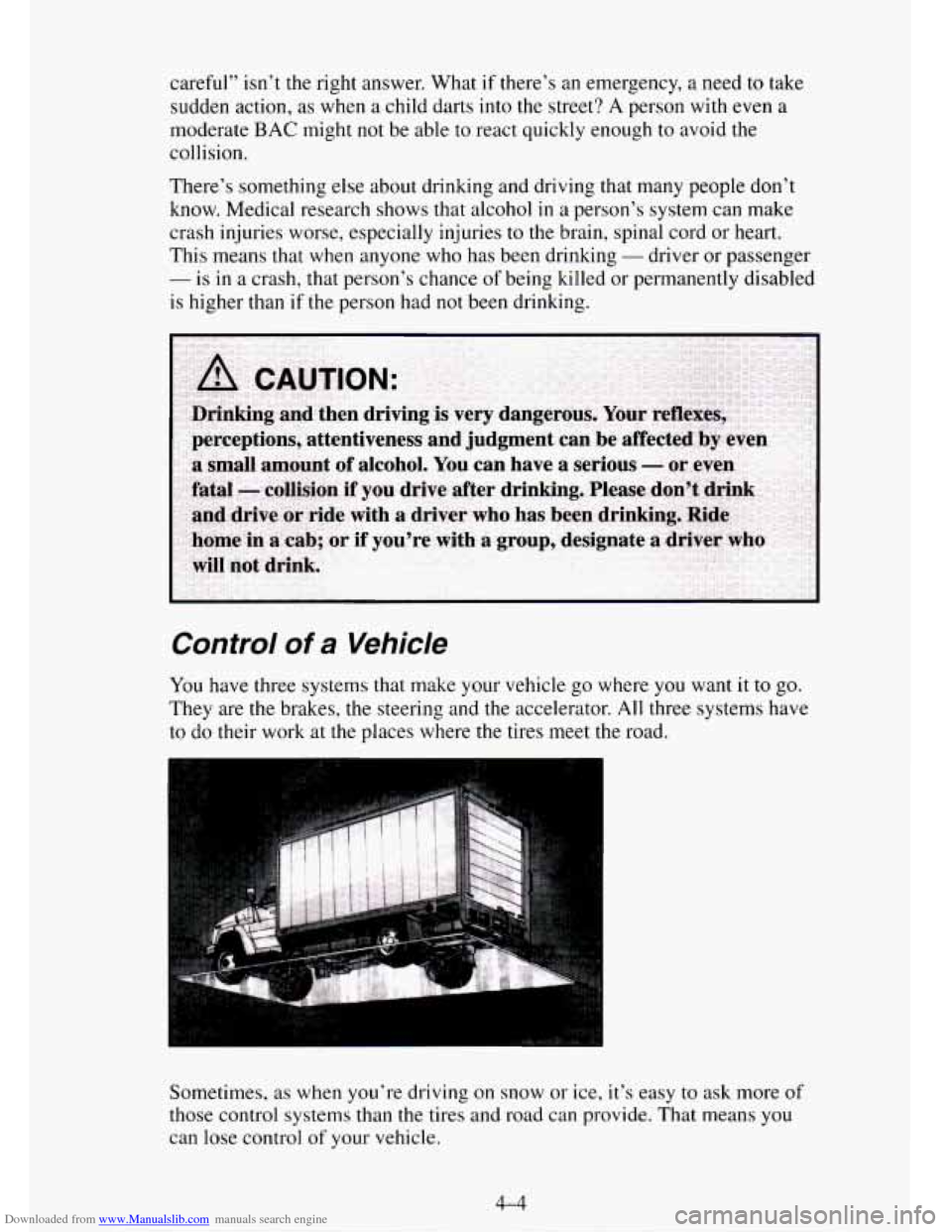
Downloaded from www.Manualslib.com manuals search engine careful” isn’t the right answer. What if there’s an emergency, a need to take
sudden action, as when
a child darts into the street? A person with even a
moderate BAC might not be able to react quickly enough to avoid the
collision.
There’s something else about drinking and driving that many people don’t
know. Medical research shows that alcohol
in a person’s system can make
crash injuries worse, especially injuries to the brain, spinal cord
or heart.
This means that when anyone who has been drinking
- driver or passenger
- is in a crash, that person’s chance of being killed or permanently disabled
is higher than
if the person had not been drinking.
Control of a Vehicle
You have three systems that make your vehicle go where you want it to go.
They are the brakes, the steering and the accelerator. All three systems have
to
do their work at the places where the tires meet the road.
Sometimes, as when you’re driving on snow or ice, it’s easy
to ask more of
those control systems than the tires and road can provide. That means you
can lose control
of your vehicle.